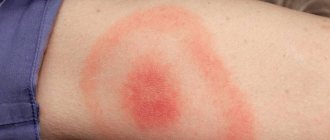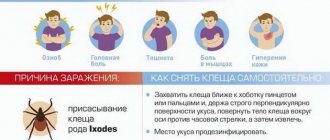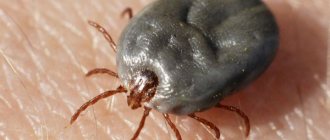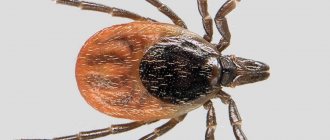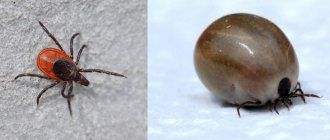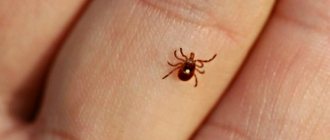Tick-borne encephalitis is a very severe acute viral disease of the nervous system. The brain and central nervous system, peripheral nervous system, and spinal cord are affected. Protection against the disease can only be vaccination. A vaccinated person can also get sick with viral tick-borne encephalitis, but in a mild form and with full recovery of the body.
Due to serious damage to the nervous system, the consequences of the disease can be extremely severe - death, partial or complete paralysis, the development of mental illnesses caused by organic damage to the brain. Age and level of development in this case have no role. Both a child and a mathematics professor can get sick.
When the peripheral nervous system and spinal part of the brain are damaged, muscle atrophy, inability to use limbs, tissue drying, and decreased sensitivity of the skin are observed.
The likelihood of getting sick after a tick bite in the European part of Russia is not too high, this is due to the spread of mandatory medical vaccinations.
Carriers of tick-borne encephalitis
The main carrier of the virus is the European taiga and forest tick, which is a hereditary carrier of the virus. That is, from an infected female the virus is transmitted to the offspring and subsequent generations of the tick. The blood of a person or animal is necessary for ticks to reproduce, which peaks in the spring and summer. This is the time when the risk of a tick bite is greatest. In addition to encephalitis, ticks carry Lyme disease, which is also a rather unpleasant disease with a slow development cycle.
It is not only the tick itself or the infected animal that is dangerous. Feces and other waste products are also dangerous. The fluid inside an encephalitis tick is a potential source of infection. When scratching the skin and getting into the bloodstream, indirect infection is quite possible.
Goats can also carry the virus. In this case, infection occurs through unprocessed goat milk consumed as food. The virus dies when boiled, does not tolerate sunlight, you can drink any boiled milk without fear.
Let's sum it up
Ticks can be carriers of various serious diseases that pose a threat not only to the health of the mother, but also to the unborn child. Toxoplasmosis is especially dangerous - if the gestational age at the time of infection does not exceed 6 months, this can lead to premature birth.
If a tick is found on the skin, it must be removed immediately. You can do this yourself using your fingers, tweezers or thread, but it is better to consult a doctor. To avoid unpleasant consequences, you should get the vaccine in advance and take precautions while walking.
How long is the incubation period?
The incubation period of the disease ranges from several hours in case of immediate development of the disease, to 14-30 days if the body is ready to resist or was vaccinated against encephalitis in childhood, and at least a small amount of antibodies remains in the blood.
During the incubation period, no painful manifestations are observed. If anti-encephalitis serum is administered during the incubation period, the temperature will rise sharply, and even delirious states are possible. However, the development of the disease can be prevented.
Immediate medical intervention and administration of immunoglobulin before the onset of the disease can reduce the risk of the disease. Immunoglobulin mimics a vaccine to some extent and contains the corresponding antibodies. The severity of the disease depends on how well it can be absorbed by the body. The effectiveness of immunoglobulin depends on the individual characteristics of the body. The medicine is a preparation made from a donor's blood - serum or plasma with already existing antibodies against tick-borne encephalitis.
The body's reaction to the introduction of serum can be painful, so treatment is carried out exclusively in hospitals. A normal reaction to the administration of serum is fever, pain, aching joints, and weakness. In rare cases, clouding and confusion may occur. Strengthening and antiviral drugs are also introduced. The serum is also used for emergency vaccination in case of epidemics.
well-fed tick
During the incubation stage there are no manifestations of diseases. For this reason, many do not seek medical help exactly when it is needed and can really help.
What is the risk of infection:
However, it is too early to panic: not all ticks are contagious. The risk of contracting Lyme borreliosis is highest; about 33% of ticks 1,000 people get sick per year in Belarus . Even if the tick is contagious, half of those bitten will simply develop antibodies, and the other half will show symptoms of the disease.
The risk of tick-borne encephalitis is 1.5% 100 people are infected per year in Belarus . Our area is characterized by the Western European type of tick-borne encephalitis; it is characterized by a more favorable course than the Far Eastern type.
Symptoms of the disease
The first symptoms of the disease are usually chills, fever, and increased temperature. In some cases, this is accompanied by aches in the bones and muscles, and an increase in temperature.
A symptom may be pain in the head; characteristic signs of meningitis are the inability to bend the head. Pain in the lumbar region, in the back. In some cases, epilepsy, convulsions, and strabismus are possible. Few people associate a sudden illness with a walk in the woods or in the park a couple of weeks ago.
A little later, the main symptoms develop - numbness of the skin, extreme weakness, high fever, convulsions, nausea. Sweating and rapid heartbeat are often noted.
After the development of the main stage of the disease, immunoglobulin and antiviral drugs are useless.
Depending on the location of the lesion, the course of the disease may differ. There are 5 main courses of the disease:
- A febrile form in which damage to the nervous system is minor, the prognosis for recovery and full recovery is positive. This form feels similar to a severe flu. Be sure to treat in a hospital to avoid relapses. After treatment, it is advisable to visit a sanatorium for complete recovery.
- Polyradiculoneuritis is a fairly common form, when the febrile form of the disease suddenly gives way to meningitis. The duration of the febrile form is about a week, inflammation of the meninges lasts about 2 weeks, recovery takes several months. The percentage of recovery with full recovery is high, the runs are generally positive. However, in this form, the development of ascending paralysis is possible.
- Meningeal is the most common form. Characterized by inflammation of the membranes of the brain. A characteristic symptom is stiffness of the neck muscles - the inability to tilt the head down and press the chin to the sternum. Symptoms include delirium, strabismus, inability to express one’s thoughts, and a sharp increase in temperature. Increased skin sensitivity and eye sensitivity to light are often noted. In mild forms it is relatively easy to treat and without consequences. After recovery, depression lasts from 2 to 12 months.
- Poliomyelitis form caused by damage to the spinal cord. General weakness gives way to nagging pain in the neck and back. The muscles become inflamed and swollen. Severe muscle pain is possible.
- Meningoencephalitic. The main signs are neurological signs - numbness of the tongue and facial muscles, shaking legs and arms, changes in behavior. This is one of the most dangerous forms, directly affecting brain cells. Changes can last a lifetime.
Unfortunately, it is impossible to predict the development of the disease in advance.
The only real protection against tick-borne encephalitis is vaccinations. Even a vaccination received in childhood seriously increases the incubation period of the disease. This gives you a chance to get medical help before the disease fully develops.
Recovery after illness
Medicine has advanced greatly. Nerve cells are restored, but this will require significant funds. You will also need therapy, massages, muscle stimulation, and restoration of sensitivity. Cases that were considered incurable just half a century ago can be cured. There is no need to despair, but it is still better to prevent the development of the disease with vaccinations and use personal aerosols in the forest. It is also worth taking care of closed clothing and, upon arriving home, carefully inspect each other for the presence of ticks. Contrary to rumors, ticks rarely bite in immediately. They spend quite a long time choosing the most vulnerable place - the armpit, groin area, stomach, scalp.
What to do if you are bitten by a tick
If you are bitten, immediately, regardless of whether you have been vaccinated or not, place the insect removed from the skin into a glass jar with a lid and take it for examination. It's free. Look up the examination address for your area on the Internet.
When removing a tick, try not to tear off its head or crush its abdomen - this is fraught with unpleasant inflammation. But even if it’s torn off, bring what’s left for examination. For tissue analysis, the tick's head and its state of health are not a prerequisite.
Prevention
Prevention of tick-borne encephalitis is pre-administered vaccinations. Only through vaccination and the presence of antibodies in the blood can one resist a viral infection.
Antibiotics can remove or reduce inflammation, fortifying drugs and bed rest will help restore health, but in reality, humanity has nothing against any virus - from influenza to encephalitis or smallpox - except vaccinations.
Ticks themselves are a problem. The toxins that ticks inject during a bite and release later are quite harmful and lead to weakening of the body. Small animals and young animals can die from multiple tick bites. Not from the volume of blood drunk - it is insignificant, but from the harmful effects of insect toxins.
When outdoors, be sure to use sprays that repel and kill ticks.
Treatment during pregnancy
If you consult a doctor in a timely manner and there are no concomitant pathologies, the outcome for the woman is favorable. If tick-borne encephalitis is diagnosed in severe form, a decision is most often made to have an abortion for medical reasons, since treatment involves the mandatory use of drugs that have a pronounced teratogenic effect. In other cases, pregnancy is maintained using medications approved for expectant mothers as therapy.
Treatment of tick-borne encephalitis
During treatment, the patient must be admitted to hospital
The patient is hospitalized for the entire duration of treatment. General principles of therapy include:
- intramuscular administration of immunoglobulin preparations;
- taking antiviral medications (“Viferon”, “Cycloferon”, “Amiksin”);
- symptomatic treatment (administration of antipyretic, detoxification, dehydration, anti-inflammatory drugs);
- prescribing injections of vitamins B and C;
- gentle diet;
- strict bed rest, restriction of movements.
Treatment of borreliosis and ehrlichiosis
Therapy during pregnancy does not differ from the treatment of other groups of patients, with the exception of the ban on the use of drugs of the tetracycline group, which have a detrimental effect on the development of the fetus. In addition to taking antibiotics, the expectant mother must observe strict bed rest and strictly follow all the instructions of the gynecologist.
Is it possible to kill ticks?
In Soviet times, forests and parks were necessarily treated with special chemicals that killed ticks. This is quite an expensive pleasure, but in principle it is possible in our time. To do this, you need to contact our service and agree on the implementation of work to prevent insect activity.
Trees, grass and shrubs are treated with special chemicals that specifically target ticks. To achieve maximum processing efficiency, the area must be large, at least a hectare.
Read more about acaricidal anti-tick treatment - HERE!
Paid or free?
The basis for a free study is a Referral to test a tick for Borrelia infection , in which the doctor must indicate the following data: last name, first name, patronymic, date of birth, address of the patient’s place of residence, place of work (study), territory where the bite occurred, date of tick attachment , number of the clinic at the place of service and area of residence (for residents of Minsk), name of the health care organization, position, full name. and the contact telephone number of the medical professional who issued the referral.
The indication for a free study is the presence of contraindications to taking an antibiotic. A tick that has bitten a pregnant woman, a child under 8 years of age, a WWII disabled person and persons equivalent to them can be examined free of charge.
An important point: it is worth clarifying the procedure for conducting a paid study; in a number of laboratories, a receipt for payment for services must be provided before conducting the study. Thus, services for examining a tick at the Minsk City Center for Hygiene and Epidemiology* should be paid for before submitting the tick for examination at the branches of OJSC Belinvestbank, ASB Belarusbank or through the ERIP system.
*Details: Recipient of the payment - State Institution "Minsk City Center for Hygiene and Epidemiology" 220013, st. Petrusya Brovki, 13 building 1, room 208. Current account 3632740391018, Directorate of OJSC "Belinvestbank" for Minsk and the Minsk region, code 739, UNP 100233760. Purpose of payment - for tick research
